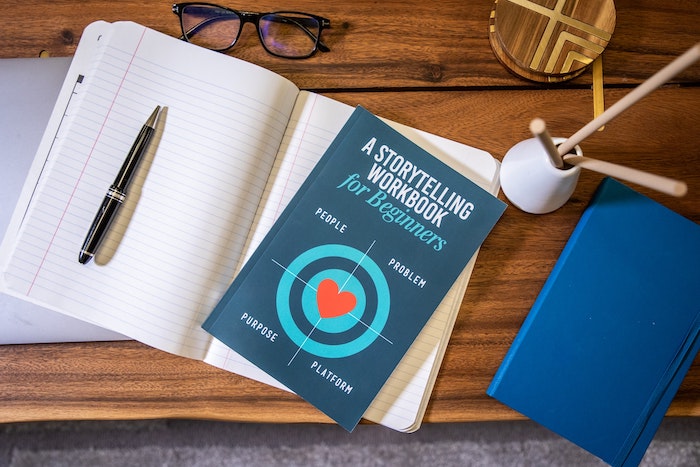How to Tell a Compelling Brand Story About Your Business [Guide + Examples] – crowdspring Blog
Businesses struggle to find a way to connect with people. One way to bridge that gap is by telling your brand story.
Storytelling is a powerful tool that allows you to build relationships with your target audience and employees by appealing to their emotions. You appear more human to your target audience when you share why your business acts the way it does.
Sharing your company’s origins, values, and culture also helps you gain your customer’s trust, build credibility, and create a strong community around your brand.
What is a brand story?
A brand story is a narrative that explains how and why your company was started and how that narrative continues to drive your company’s mission.
A brand story includes the following:
- your company’s origins and history
- values and principles
- mission and vision
- inspiration, and
- work culture
So, how do you tell your brand story? How do you make it compelling and relatable for your audience?
And what makes your brand story important?
This guide will walk you through the importance of telling your brand story, how to write a compelling brand story, and some examples to help inspire you.
How to tell a compelling brand story:
Importance of brand storytelling
Building a compelling brand story allows your business to:
- Increase customers. People are attracted to purpose-driven and transparent brands. Businesses today know that one of the most critical factors to appeal to people is marketing their brand story and values in public, especially on social media. Younger generations, specifically Gen Z, look more into a brand’s background first before they choose to support it.
- Develop trust and loyalty. You can develop a bond with your customers by sharing your brand’s humble beginnings, which can ultimately build trust and increase loyalty, allowing them to keep returning to your business.
- Separate yourself from the competition. One way to stand out from competitors is to tell a compelling brand story. Many people consider a brand’s ethics and values to be an essential factor that helps determine their choice of which business to support.
- Helps communicate your value. Without a brand story, your business can appear gray and unimportant to people. Sharing your story allows you to show why customers should choose you and help you justify your products or services.
Want a free brand review?
Answer 5 short questions and we will send a custom report with actionable insights and specific actions you can take to build a stronger brand.
We just emailed the info to you.
How to write your brand story
Gather your best and harrowing stories about your business and prepare your pen and paper. It’s time to start drafting your brand story.
Follow these five basic steps to get started:
1. Determine your brand’s purpose
Your brand didn’t just magically exist. There was something that triggered or inspired you to start a business.
Identify these factors first to start creating your brand story. Ask questions such as:
- Why does our brand exist?
- How can my business provide value to people?
- What is our brand’s mission? Values and principles?
- What inspired me to build my brand?
Take a step back and list everything that inspired you to create your business. You don’t need to have an unconventional origin story; you need to highlight what made you passionate enough to start your business.
By answering these questions, you’re already drafting the main content of your brand story. These will also remind you how you came to be as a business and help motivate you to improve your brand further.
2. Understand your products and services
Analyze how your products or services fit into your story. Remember why you chose to sell them and how they helped shape your brand. Start by asking:
- How are the quality and price of your products or services?
- How do your products make your customers feel?
- Do your products help solve a problem effectively?
- What makes your products or services different from your competitors?
You must make your products relatable to your brand story. For example, if you say you started your clothing business at home using recycled materials, people will expect that your current products are also recycled.
Make sure you find the connection between your brand’s origins and state how it has evolved to avoid confusion. The goal is to make your product an essential aspect of your business’s story, not just a prop that allows you to make money.
3. Know your audience
Think of who you’re talking to when building your brand story. Understanding your audience is a critical factor in communicating your story.
To understand your audience, ask the following questions:
You can begin to analyze your target audience by imagining what kind of person they are. Be specific and detailed in describing your ideal customer to see them as a real person.
For example, it’s best to create a buyer persona and imagine as if you’re facing your ideal customer. Think of how you will interact with them, what kind of words you use, and more. Doing so will help you find the language that they will best understand.
4. Make your brand story concise and clear
As much as you want to tell your brand’s story from its birth to your future business plans, you need to keep it concise to keep people interested.
No one wants to spend time reading a novel-length brand story. People are likelier to read your story if it’s short and easy to understand.
When writing your brand story, consider the following:
- Word count. When drafting your brand story, you can write as much as you want but make sure to edit and refine it as much as possible. Stick to a realistic word count as the primary goal when editing. You can compare and study your competitors’ stories as examples to make the process easier.
- Content and words. Ensure that your story has all the necessary and honest information about your brand. Don’t just add any random events to make it more interesting. Instead, you can use colorful adjectives here and there but don’t overdo it. The important thing is it’s clear and can convey your business’s story properly.
- Experience. Make the reading experience easy by using simple and conversational words your target audience would most likely use. The goal is to make your target audience feel all the emotions you want to make them feel without making it complicated.
5. Aim to be relatable
You must keep your business’s story accurate to its experiences, but you can also make it relatable by highlighting some of your most human experiences.
For example, including your brand’s milestones, such as your first sale or your first physical store, can be a relatable experience for many. The proud emotions of earning something you’ve worked hard for are something that your audience will significantly relate to and appreciate.
Your humbling experiences as a brand humanizes you and allow you better connect with the right people. Don’t be afraid to include these to help add more personality to your brand story.
Tips for creating a compelling brand story
Create characters. Like any other story, your brand story should include exciting characters to make it fun. Making up characters makes your story more engaging and pushes people to finish your story. Ensure that the characters you create reflect your brand’s personality well.
Highlight your brand’s values. Your brand’s values, principles, mission, and vision should be evident throughout your story. Don’t just tell something fun and exciting about your business. People should clearly understand your business and why it’s the way it is.
Be consistent. Use your brand voice and tone consistently. Don’t be friendly or conversational in the first part and end in a serious tone the next. This will confuse people and make them lose interest in what you say.
Include visuals. You can also include pictures or videos to document your brand story to make it more authentic and fun. Photos or videos of your business’s experiences help people see your business’s growth through the years, allowing them to connect with you better.
Appeal to people’s emotions. Don’t be afraid to use powerful words to ignite an emotional response from your readers. People may forget your story, but they surely won’t forget how you made them feel while reading your brand story. But make sure to balance it, stay faithful, and don’t overdo it. By appealing to emotions, you’ll ensure that people have a similar reaction in the future when they see your company logo or business name.
Best brand story examples to inspire you
1. Burt’s Bees
The famous skincare brand Burt’s Bees firmly adheres to its mission and values. The brand ensures to remain transparent in where they source its ingredients, assuring its customers that they are all-natural and have been consistent since it was founded.
The company also included attractive visuals, such as photos of its co-founders, in its story to keep people interested and appear more relatable to its audience.
2. Warby Parker
Warby Parker smartly positions itself as the alternative to famous and expensive glasses brands. Its story is centered around being relatable to its customers and appeals to their frustrations about not being able to afford costly quality eyeglasses.
Its brand story highlights its humble origins, ensuring to point out the company’s mission, inspiration, and vision to help people afford quality glasses without breaking the bank.
3. Zendesk Alternative
Zendesk is a known customer support software for small businesses. Its story successfully painted the company as more human and appealing to its customers.
To make its brand story more interesting, it launched the Zendesk Alternative. The site includes an entertaining video about a fictional indie rock band showcasing the importance of customer service to people through a cheesy jingle.
4. Drift
Drift is a conversational marketing platform that helps businesses connect with sales prospects through conversations and interactions instead of website forms.
By removing forms from its website, Drift aligned its product with its mission and values. This story demonstrated the effectiveness of intelligent chatbots instead of forms and made Drift more relatable.
Your brand story doesn’t have to be a fairytale to gain people’s support. It needs to include three key elements to win people’s hearts: relatable, entertaining, and accurate. So, focus on building a story that aims to showcase your company’s personality and growth while highlighting how these factors can help add value to people.
We regularly update this brand story guide. We most recently updated this guide on October 25, 2022.
Interested in other types of businesses or how-to guides? Here are our comprehensive guides:
How to Start a Business: The Complete Step-by-Step Guide to Starting a Business in 2022
How to Write a Business Plan (2022)
How To Create an Effective Marketing Plan for Your Business (2022)
How to Start an LLC in 7 Simple Steps (2022)
Branding: The Definitive Guide for 2022
The Definitive Guide to Successfully Rebranding in 2022
What is Brand Identity? And How to Create a Unique and Memorable One in 2022
The Ultimate Small Business Guide to Brand Equity in 2022
Brand Archetypes and How They Can Help Your Business: The Definitive Guide
The Definitive Small Business Guide to Brand Pillars in 2022
How to Tell a Compelling Brand Story About Your Business [Guide + Examples]
The Complete Guide on How to Name a Business
Brand Strategy 101: How to Create an Effective Branding Strategy [GUIDE]
The Definitive Content Marketing Guide
Social Media Marketing: The Ultimate Small Business Guide for 2022
Local SEO: The Definitive Small Business Guide (2022)
Marketing Funnels: The Definitive Small Business Guide (2022)
Cross-Selling and Upselling: The Ultimate Guide (2022)
How to Start a Small Business Blog
Small Business Guide to Lifecycle Email Marketing: How To Grow Your Business Faster
Direct to Consumer (DTC) Marketing: The Complete Guide, with Strategies, Tactics, and Examples (2022)
Google Ads: The Ultimate Small Business Guide (2022)
The Ultimate Guide to Using Twitter for Business in 2022
YouTube Marketing: The Complete Small Business Guide 2022
Instagram Marketing: The Ultimate Small Business Guide for 2022
How to Use LinkedIn: The Ultimate Small Business Marketing Guide
The Ultimate Small Business Guide to Marketing on TikTok
How to Start A Podcast: A Complete Step-by-Step Guide (2022)
SMS Marketing: The Ultimate Small Business Guide [2022]
Public Relations Guide for Small Business (7 Proven PR Tactics)
How to Start a Consulting Business in 2022: The Complete Step-by-Step Guide
How to Start a Real Estate Business in 2022: Complete Step-by-Step Guide
How to Start a Trucking Business in 2022: The Complete Guide
How to Start a Candle Business: A Step-by-Step Guide With Tips and Insights (2022)
How to Start a Property Management Company
How to Start a Successful Online T-Shirt Business in 2022: The Definitive Guide
How to Start an eCommerce Business: A Step-by-Step Guide To Take Your Business Online (2022)
Nonprofit Branding: Complete Guide to Building a Strong Nonprofit Brand in 2022
How to Start a Cleaning Business in 2022: The Complete Guide
6 Businesses You Can Start For Less Than $1,000
Marketing Psychology: What You Must Know To Supercharge Your Marketing
What is a DBA and How to File One For Your Business
How to Start a Clothing Line or Clothing Brand From Scratch in 2022: The Definitive Guide
How to Start a Brewery Business in 2022: The Complete 9 Step Guide
How to Start a Medical Marijuana Dispensary Business in 2022
How to Start an Etsy Shop: Your Comprehensive, No-Stress Guide to Starting an Etsy Shop in 2022
How to Start a Photography Business in 2022: The Complete Step-by-Step Guide
How to Start a Business in Texas: The Complete Step-by-Step Guide (2022)
The Definitive Guide to Creating a Compelling Visual Brand for Your Restaurant in 2022
Conversion Rate Optimization (CRO) Guide: How to Make Your Website Work Smarter (2022)
Facebook Messenger Chatbot Marketing: The Definitive Guide (2022)
Branding for Food Trucks: The Definitive Guide (2022)
Source by www.crowdspring.com











